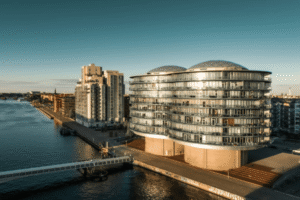Imagine walking through Danish streets glowing with fairy lights while the smell of roasted almonds and hot gløgg fills the crisp winter air. In Denmark, Christmas is not only a holiday but a feeling of warmth, family, and joy. Every corner shines with candles, hearts, and snowflakes. Copenhagen streets sparkle with red and white lights, while towns across the country host markets full of handmade crafts, woolen gifts, and sweet treats. People gather early to decorate their homes, light Advent candles, and prepare for a long season of celebration.
What makes Christmas here so special is that Danes celebrate it on the evening of December 24. They sing, dance, and share stories by candlelight. If you wish to feel true hygge during winter, continue reading to explore how Danes celebrate Christmas, where to find the best markets, and what to taste during this magical time.
Key Takeaways
- Christmas in Denmark is celebrated on the evening of December 24 with dinner, songs, and dancing around the tree.
- Danes have unique Christmas customs, such as hiding an almond in rice pudding or decorating with little elves called nisser.
- Christmas markets in Copenhagen and Jutland fill December with light, music, and local crafts.
- Traditional dishes include Danish food such as roast pork, caramel potatoes, and sweet rice pudding with cherry sauce.
Christmas Traditions in Denmark
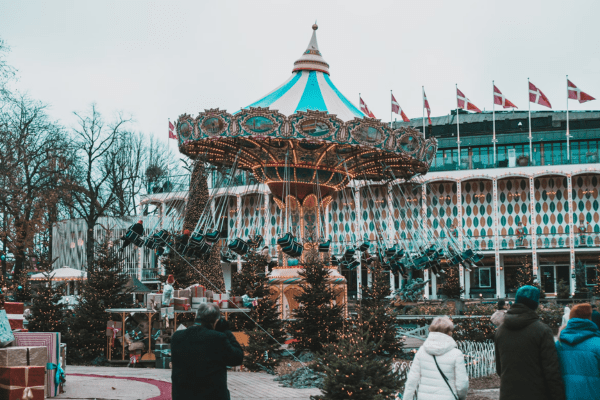
Christmas in Denmark, known as jul, combines ancient customs with modern warmth. The word jul comes from pre-Christian times, showing how old these celebrations truly are. Danes keep many traditions that connect family, light, and togetherness.
Why Danes Celebrate on December 24
In Denmark and other Scandinavian countries, people celebrate on Christmas Eve instead of December 25. Families gather in the evening for a long dinner followed by carols and gift-giving. This tradition started in the Middle Ages when religious festivals began the night before the holy day. Over time, Christmas Eve became the heart of the celebration, and it remains the highlight of the Danish festive season.
10 Unique Danish Christmas Traditions
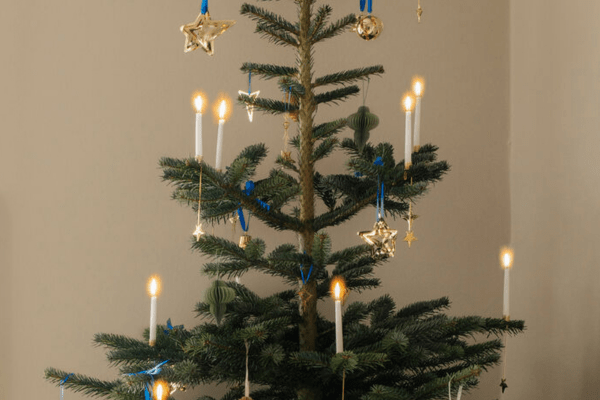
1. The Hidden Almond Game
Families serve rice pudding called risalamande, which is made from rice, cream, and almonds. One whole almond hides inside, and whoever finds it wins a small prize, often a marzipan pig. The game adds laughter and excitement to the meal.
2. Dancing Around the Tree
After dinner, families join hands and dance around the Christmas tree while singing carols. The tree is real, often decorated with candles, woven hearts, and Danish flags. Also, the circle dance represents unity and joy.
3. The Mischievous Nisse
A Nisse is a small house elf believed to protect families and farms. People leave bowls of porridge for him to keep him happy. Today, Nisse decorations and small figurines appear everywhere during December.
4. Advent Candles and Calendars
Danes mark the four Sundays before Christmas with an Advent wreath that holds four candles. They also enjoy countdown candles marked with numbers from one to twenty-four, burning a little each day. These traditions build excitement throughout December.
5. Little Christmas Eve on December 23
The day before Christmas Eve is called Little Christmas Eve. Families decorate the tree, wrap gifts, and enjoy cookies while preparing for the big night. It is a quiet evening that brings calm before celebration.
6. Julefrokost or Christmas Lunches
During December, colleagues and friends gather for Christmas lunches. These feasts include open sandwiches with herring, liver pâté, and schnapps. The lively gatherings celebrate togetherness and mark the season of joy.
7. Christmas Beer Day
Every November, Danish breweries release their seasonal Christmas beer. Bars across the country open their doors, music fills the streets, and the holiday spirit begins. Since Danes love their beers, this modern tradition is eagerly awaited each year.
8. Paper Hearts and Street Lights
Across cities, bright red paper hearts hang from windows and trees. Streets are filled with warm lights and stars, turning Denmark into a winter wonderland. The decorations reflect love, kindness, and togetherness.
9. Saint Lucia
Although not entirely Christmas-related, each December 13, people celebrate Saint Lucia’s Day with candlelit processions. In Copenhagen, hundreds of kayaks covered in lights glide through the canals, creating an unforgettable sight.
10. Decorating the Tree with Real Candles
Danish families use real candles instead of electric lights on their Christmas trees. Each candle is placed carefully on the branches and lit on Christmas Eve when everyone gathers to sing and dance around the tree. The warm glow creates a magical and intimate atmosphere that captures the true spirit of Danish hygge.
Through these traditions, Danes celebrate both their history and their love for simple joys. Every song, candle, and shared meal reflects the Danish way of creating warmth even on the darkest winter days.
Christmas Markets in Denmark
During December, cities and villages across Denmark fill with Christmas markets. Visitors enjoy sweet scents, handmade crafts, and twinkling lights. Below are some of the best markets to visit in Copenhagen and Jutland.
Copenhagen Christmas Markets
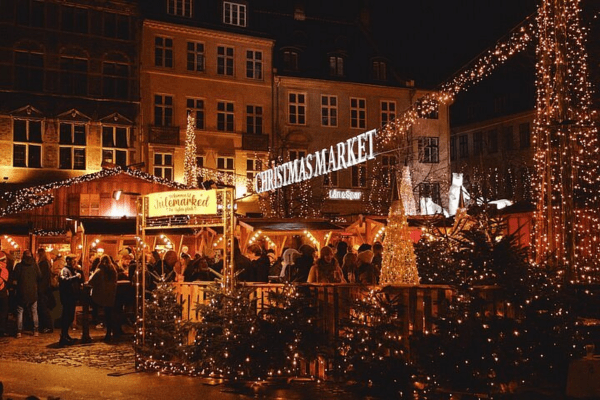
Tivoli Gardens Christmas Market
Tivoli Gardens turns into a magical Christmas world with thousands of lights, decorated trees, and stalls offering gifts and food. Families can enjoy rides, live shows, and festive treats while snowflakes fall gently around.
Højbro Plads Christmas Market
Located in central Copenhagen, Højbro Plads market features dozens of wooden stalls selling ornaments, candles, wool products, and sweets. The atmosphere is cheerful, with music and warm drinks filling the air.
Nyhavn Christmas Market
Nyhavn’s harbor transforms into a charming Christmas street lined with small cabins. Visitors can sip gløgg, browse handmade gifts, and take photos of colorful houses reflecting on the water.
Kongens Nytorv Christmas Market
Near the Royal Theatre, Kongens Nytorv market offers cozy stalls with crafts, decorations, and traditional food. The square glows with lights, making it one of the most romantic places in Copenhagen.
Christiania Christmas Market
Inside Den Grå Hal in Christiania, local artists sell unique handmade items, jewelry, and art. The atmosphere is relaxed, creative, and full of character, offering an alternative Christmas experience.
Jutland Christmas Markets
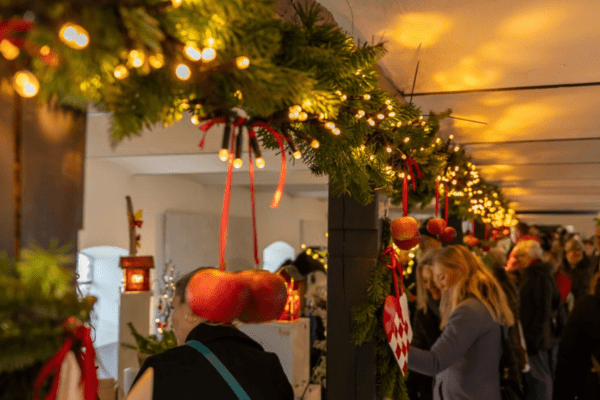
Esbjerg Christmas Town
Esbjerg’s city center becomes a festive village with hundreds of stalls, a skating rink, and live music. The coastal setting gives a special charm to the celebration.
Aalborg Christmas Market
Located in Gammeltorv Square, Aalborg’s market offers food, drinks, and crafts. Visitors can also explore the nearby zoo’s light displays, creating a full Christmas outing.
Clausholm Slot Christmas Market
Set inside the beautiful Clausholm Castle near Randers, this market welcomes visitors into candlelit halls filled with handmade crafts, local art, and festive food. The castle’s baroque interiors and peaceful surroundings create an elegant and enchanting atmosphere that feels like stepping into a Christmas fairy tale.
Knivholt Manor Market
In Frederikshavn, Knivholt Manor hosts a rustic market surrounded by countryside. Families can enjoy local crafts, horse rides, and mulled wine. The setting feels peaceful and authentic.
Sønderjylland Christmas Markets
Southern towns like Augustenborg and Als celebrate with small village markets. Visitors find local food, carriages, and traditional music. These cozy gatherings capture the true spirit of Danish community life.
Each market offers something special, from grand urban lights to intimate rural charm. Together, they create a Christmas experience that combines creativity, warmth, and tradition.
Top 5 Christmas Foods and Desserts in Denmark
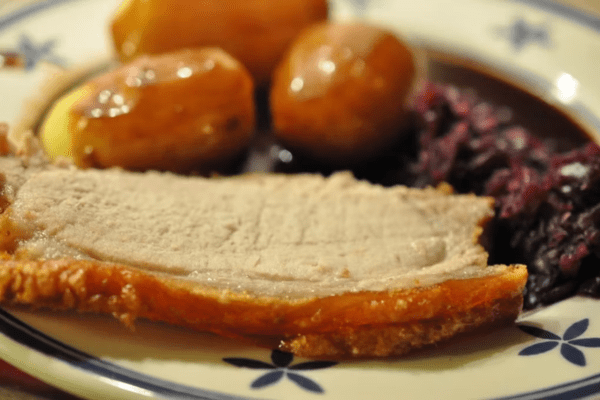
- Flæskesteg (Roast Pork): A classic Christmas Eve dish served with red cabbage, brown gravy, and crispy crackling. It represents comfort and family tradition.
- Brunede Kartofler (Caramel Potatoes): Small potatoes cooked in butter and sugar until golden brown. They add sweetness to the main meal.
- Risalamande (Rice Pudding): Cold pudding with cream and almonds served with cherry sauce. One hidden almond brings a playful competition.
- Æbleskiver (Pancake Balls): Round, fluffy pancakes eaten with sugar and jam. They are perfect for family gatherings and holiday cafés.
- Æbleflæsk (Apple and Pork): A sweet and savory mix of apples and pork slices that dates back to the countryside kitchens of Denmark.
Conclusion
From glowing city streets to candlelit homes, Christmas in Denmark blends old traditions with cozy celebration. Families gather on December 24 to sing, share food, and enjoy the joy of giving. Visitors can explore lively markets, taste comforting dishes, and feel the unique sense of hygge that defines Danish winter.
For a deeper and more personal experience, join an Amitylux private tour in Copenhagen. You can create your own route, choose your favorite sights, and enjoy Denmark exactly the way you want. To discover more about Danish charm, visit our posts about Nyhavn and hygge. They will inspire you to make your next Christmas truly unforgettable.
Frequently Asked Questions
How do they celebrate Christmas in Denmark?
Danes celebrate on the evening of December 24 with a big family dinner, dancing, and gifts. Homes are filled with candles, songs, and warm food.
Is Denmark good to visit at Christmas?
Yes. Denmark shines during December with markets, decorations, music, and a peaceful holiday atmosphere that feels both joyful and relaxing.
How long is Christmas in Denmark?
The Christmas season starts in late November and lasts until the end of December. Some traditions continue until the New Year.
Why is Christmas on the 24th in Scandinavia?
Scandinavians celebrate on December 24 because old Christian and Nordic customs placed the main feast the night before the holy day. The evening became the heart of celebration.

